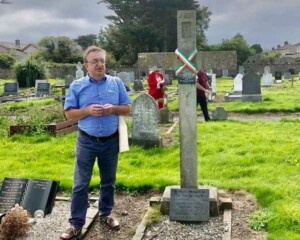THE cemetery dubbed “the healthiest graveyard in Ireland” is being rediscovered and its history told by a local group.
Located on the coast road to Howth, Kilbarrack Cemetery in Bayside is situated on the grounds of Kilbarrack Church, which is now in ruins.
The church, believed by many to have been here since the 6th century, was built for the assistance of shipwrecked sailors and is sometimes known as ‘the Mariner’s Church’.
For a period, ships entering Dublin Bay paid duties to the authorities in order to maintain the church.
The Kilbarrack Cemetery Project was formed to research and highlight the stories of those laid to rest in the ancient graveyard.
Margaret Crowley from Bayside is a researcher with the project and she explained how the group came about.
“When we were restricted to local walks some of us took a renewed interest in the history on our doorstep,” Margaret told Northside People.
“We found a wealth of information on this graveyard and decided to set up an informal group and enter a project for National Heritage Week. Every day we are finding more information.”
Among those buried in the cemetery are Eoin Mac Néill who as leader of the Irish
Volunteers issued the famous countermanding order at Easter 1916.
He took the pro-Treaty side in 1922 and in the same family grave is his son Brian, an anti-Treaty IRA Officer who was killed in Sligo during the Civil War.
Writer Brendan Behan mentions Kilbarrack in his book ‘Borstal Boy’ where he describes it as the healthiest graveyard in Ireland “because it was so near the sea.”
Many of his relatives were buried there and he even writes of the Tricolour flying over Dan Head’s grave.
Head was a member of the IRA killed in the battle of the Custom House in May 1921 and for many years his father flew the Tricolour over his son’s last resting place.
He was only 17-years-old as was Thomas Wall who was killed in the Four Courts during the Civil War.

Already the project has had two walking tours of the graveyard by local historian and councillor Mícheál Mac Donncha (pictured above) and more are planned.
Between them those buried in these graves encapsulate the tumultuous events of 100 years ago.
It includes tales of gun-running, jail-breakers, internees, language revival and foundation of the Irish Volunteers from 1913 to 1923.
These and other stories are told in a video made by the project which can be found on its Facebook Page ‘Kilbarrack Cemetery, Bayside’.
You can also go to the Heritage Week website on www.heritageweek.ie/projects/kilbarrack-cemetery-bayside
The project welcomes further information and you can get in touch on their Facebook page.